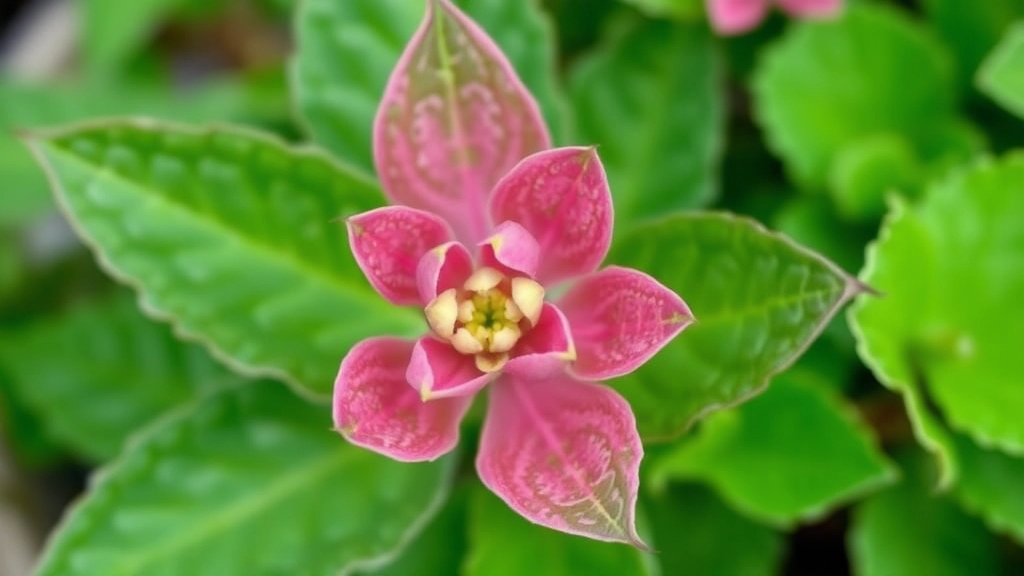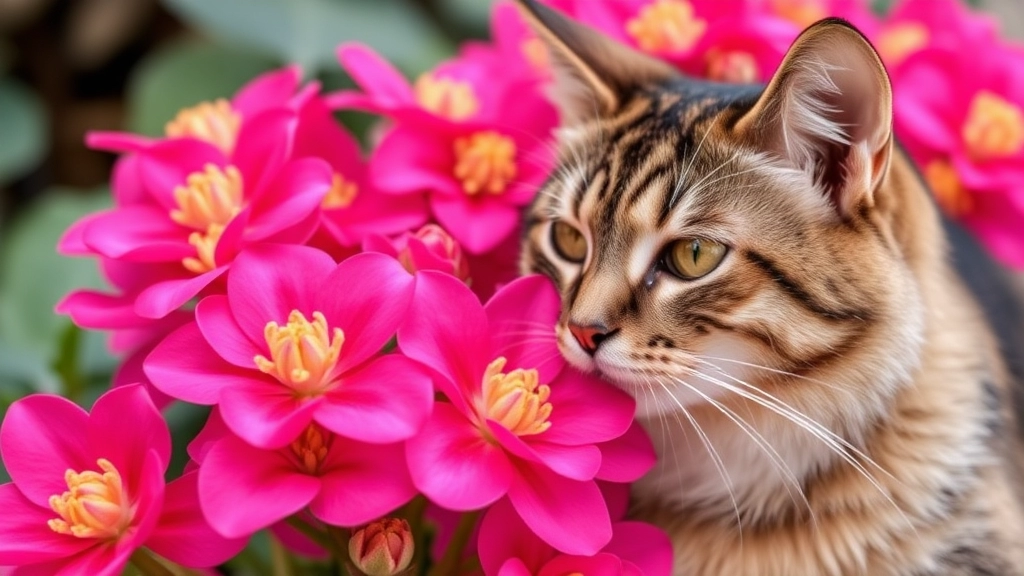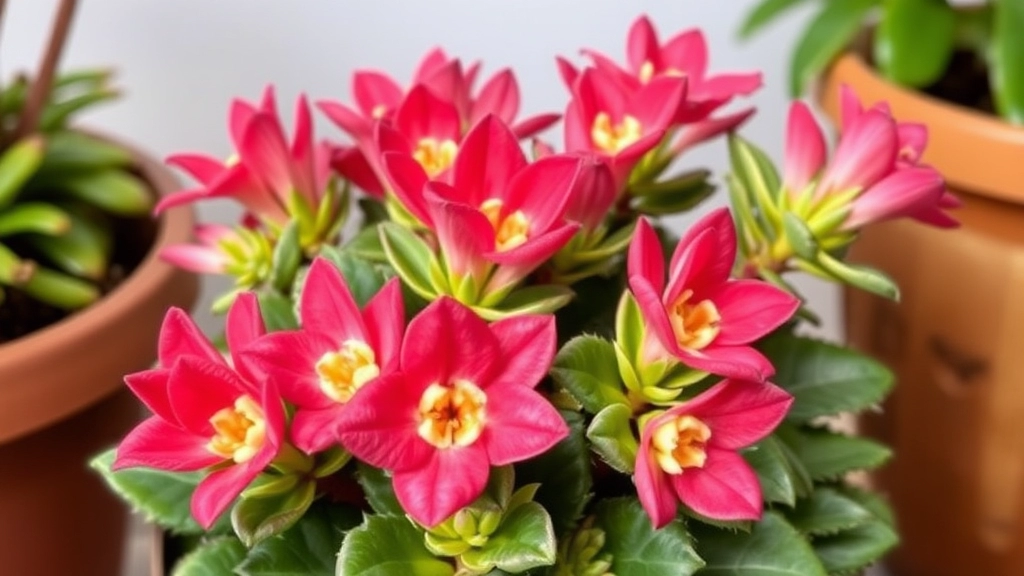Kalanchoe Plants and Cat Safety
As a florist, you might adore the vibrant beauty of Kalanchoe plants, but did you know that Kalanchoe is toxic to cats? It’s crucial to be aware of this if you’re a cat owner or frequently have feline visitors. Let’s dive into why this plant poses a risk to our furry friends and what you can do to keep them safe.
Risks of Kalanchoe for Cats
When it comes to Kalanchoe, every part of the plant is potentially harmful to cats. Ingesting even a small amount can lead to symptoms like:
- Vomiting
- Diarrhoea
- Lethargy
Severe cases might even result in heart issues. If you suspect your cat has nibbled on Kalanchoe, it’s essential to seek veterinary care immediately. Being informed about the risks can help ensure that your home remains a safe haven for your pets.
Identifying Kalanchoe Plants
Many cat owners worry about the safety of their pets around houseplants. One plant that often raises concerns is Kalanchoe.
What is Kalanchoe?
Kalanchoe is a popular succulent known for its vibrant flowers and easy care. However, its beauty comes with a caveat.
Characteristics of Kalanchoe:
- Leaves: Thick, fleshy, and often serrated.
- Flowers: Clusters of small, tubular blooms in various colours, including pink, red, and yellow.
- Growth Habit: Typically grows upright and can reach heights of up to 1 metre.
Common Species:
- Kalanchoe blossfeldiana: The most commonly found variety, often sold in florists.
- Kalanchoe tomentosa: Known for its fuzzy leaves, sometimes called ‘panda plant’.
Where to Find Kalanchoe:
You can find Kalanchoe in garden centres, florists, and even supermarkets. Its popularity means it’s readily available, but this also increases the risk of accidental ingestion by your feline friend.
Toxic Components of Kalanchoe

So, you’ve got a Kalanchoe plant in your home. It’s beautiful, but here’s the kicker: it can be toxic to our furry friends.
Kalanchoe contains compounds that can be harmful to cats. The main culprits are bufadienolides, which are a type of cardiac glycoside. These toxins can mess with your cat’s heart and lead to some serious health issues.
Here’s a quick breakdown of how these toxic components can affect your kitty:
- Cardiac Issues: The bufadienolides can cause irregular heartbeats and even heart failure in severe cases.
- Gastrointestinal Distress: Cats may experience vomiting, diarrhoea, or abdominal pain after munching on Kalanchoe.
- Neurological Symptoms: In some instances, you might notice your cat acting unusually lethargic or disoriented.
It’s crucial to keep an eye on your cat if you have Kalanchoe around.
Symptoms of Kalanchoe Poisoning in Cats
As a cat owner, it’s natural to worry about your furry friend’s health, especially when it comes to plants like Kalanchoe. Understanding the symptoms of Kalanchoe poisoning is crucial for timely intervention.
Recognising the Signs
If your cat has ingested Kalanchoe, you may notice a range of symptoms. Here are the most common indicators to watch for:
- Vomiting: This is often the first sign. Your cat may vomit shortly after ingestion.
- Diarrhoea: Loose stools can occur, which may lead to dehydration if not addressed.
- Lethargy: A sudden drop in energy levels can indicate something is wrong.
- Loss of Appetite: If your cat is suddenly uninterested in food, it could be a warning sign.
- Abdominal Pain: Cats may exhibit signs of discomfort, such as hiding or avoiding touch.
- Tremors: Muscle tremors or shaking can occur, indicating neurological distress.
If you observe any of these symptoms, it’s essential to act quickly. The sooner you can identify and address Kalanchoe poisoning, the better the outcome for your cat. For more detailed information on this topic, you can refer to our guide on Florist Kalanchoe toxicity to cats. Additionally, understanding the safety information regarding Kalanchoe plants can help you prevent such incidents in the future.
Immediate Actions to Take If Your Cat Ingests Kalanchoe

If you suspect that your cat has ingested Kalanchoe, your mind may race with worry. What should you do next?
First and foremost, remain calm. Quick and informed actions can make a significant difference in your cat’s well-being.
Steps to Take Immediately
- Assess the Situation:
- Check how much of the plant your cat has eaten.
- Observe any immediate symptoms, such as vomiting or lethargy.
- Contact Your Veterinarian:
- Call your vet or an emergency animal clinic right away.
- Provide details about the plant, the amount ingested, and any symptoms observed.
- Do Not Induce Vomiting Without Guidance:
- Inducing vomiting can sometimes do more harm than good.
- Wait for professional advice before taking further action.
- Monitor Your Cat:
- Keep a close eye on your cat’s behaviour and health.
- Note any changes, as this information can be vital for your vet.
- Gather Information:
- If possible, take a photo of the Kalanchoe plant.
- This can help the vet identify the specific type of Kalanchoe and its potential effects.
- Prepare for the Vet Visit:
- If advised to bring your cat in, prepare a carrier and any relevant information.
- Bring along any remaining plant material for identification.
Safe Alternatives to Kalanchoe for Cat Owners
As a cat owner, you may be concerned about the potential dangers of keeping certain plants in your home. Kalanchoe, while beautiful, poses risks to our feline friends. Thankfully, there are many safe alternatives that can enhance your living space without jeopardising your pet’s health.
Safe Plant Options for Cats
Here are some cat-friendly plants you can consider:
- Spider Plant (Chlorophytum comosum)
Known for its air-purifying properties, the spider plant is non-toxic to cats and easy to care for. - Boston Fern (Nephrolepis exaltata)
This lush fern thrives in humidity and is safe for your feline companions. - Bamboo Palm (Chamaedorea seifrizii)
A great choice for low light conditions, the bamboo palm is also non-toxic to cats. - Areca Palm (Dypsis lutescens)
This attractive palm can brighten up any room and is safe for your pets. - Cat Grass (Dactylis glomerata)
Specifically designed for cats, this grass can help with digestion and is a fun treat for your furry friend.
Tips for Choosing Safe Plants
When selecting plants, keep these tips in mind:
- Research Plant Varieties: Always check if a plant is safe for cats before bringing it into your home.
- Opt for Non-Toxic Labels: Look for plants labelled as non-toxic to pets at garden centres.
- Monitor Your Cat: Even safe plants can cause mild stomach upset if ingested in large quantities.
By choosing cat-friendly plants, you can create a beautiful, safe environment for both you and your feline companion. If you’re still interested in keeping Kalanchoe, you might want to read about the toxicity risks and safety tips associated with it. Additionally, for those who love succulents, the complete guide to caring for Kalanchoe succulents can provide useful insights on how to safely manage these plants around pets.
Preventing Plant Poisoning in Cats
Now that we’ve covered the dangers of Kalanchoe, let’s chat about how to keep our furry friends safe from plant poisoning in general.
As cat owners, we often worry about what our pets might nibble on.
Here’s how to prevent plant poisoning:
- Research Before You Buy: Always check if a plant is safe for cats before bringing it home. Websites like the ASPCA have great lists of toxic and non-toxic plants.
- Create a Cat-Free Zone: Designate areas in your home where plants are off-limits. Cats are curious, so keeping plants out of reach can help.
- Opt for Cat-Friendly Plants: Choose plants known to be safe for cats, like catnip, spider plants, or Boston ferns. These can add greenery without the worry.
- Educate Yourself: Familiarise yourself with the signs of plant poisoning. Knowing what to look for can make a big difference in an emergency.
- Use Deterrents: If your cat has a habit of chewing on plants, consider using natural deterrents like citrus peels or commercial sprays that discourage chewing.
- Regularly Check Your Plants: Keep an eye on your plants for any signs of damage or nibbling. If you notice your cat showing interest, it might be time to move the plant.
By taking these steps, you can create a safer environment for your feline friend. For more information on specific Kalanchoe varieties and their care, check out our Kalanchoe Panamensis Flower Care and Propagation Guide and our Ultimate Guide to Growing and Caring for Succulent Plant Kalanchoe.
FAQs on Kalanchoe Toxicity in Cats
What makes Kalanchoe toxic to cats?
Kalanchoe contains compounds known as bufadienolides, which are a type of cardiac glycoside. These toxins can interfere with your cat’s heart function and cause serious health issues.
What symptoms should I look for if my cat ingests Kalanchoe?
Common symptoms include irregular heartbeats, vomiting, diarrhoea, abdominal pain, lethargy, and disorientation. It’s crucial to monitor your cat closely if you suspect ingestion.
What should I do if my cat eats Kalanchoe?
First, remain calm. Assess the situation by checking how much of the plant your cat has eaten and observe any immediate symptoms. Contact your veterinarian or an emergency animal clinic right away for further guidance.
Should I induce vomiting if my cat eats Kalanchoe?
No, do not induce vomiting without professional guidance. Inducing vomiting can sometimes do more harm than good. Wait for advice from your veterinarian.
What information should I provide to the vet?
When you contact your vet, provide details about the plant, the amount ingested, and any symptoms observed. If possible, take a photo of the Kalanchoe plant to help the vet identify the specific type and its potential effects.
How can I prepare for a vet visit if my cat has ingested Kalanchoe?
If advised to bring your cat in, prepare a carrier and gather any relevant information, including any remaining plant material for identification. This can help the vet in diagnosing and treating your cat effectively.
Can Kalanchoe cause long-term health issues in cats?
In severe cases, the toxic components of Kalanchoe can cause long-term health issues, particularly related to the heart. Immediate veterinary care is crucial to mitigate these risks.
Is it safe to keep Kalanchoe plants if I have cats?
Given the potential risks, it is advisable to keep Kalanchoe plants out of reach or avoid having them in your home if you have cats. Consider opting for non-toxic plants instead.
References
-
Kalanchoe – Pet Poison Helpline
-
Kalanchoe – ASPCA
-
Kalanchoe Toxicity – Cornell University College of Veterinary Medicine
